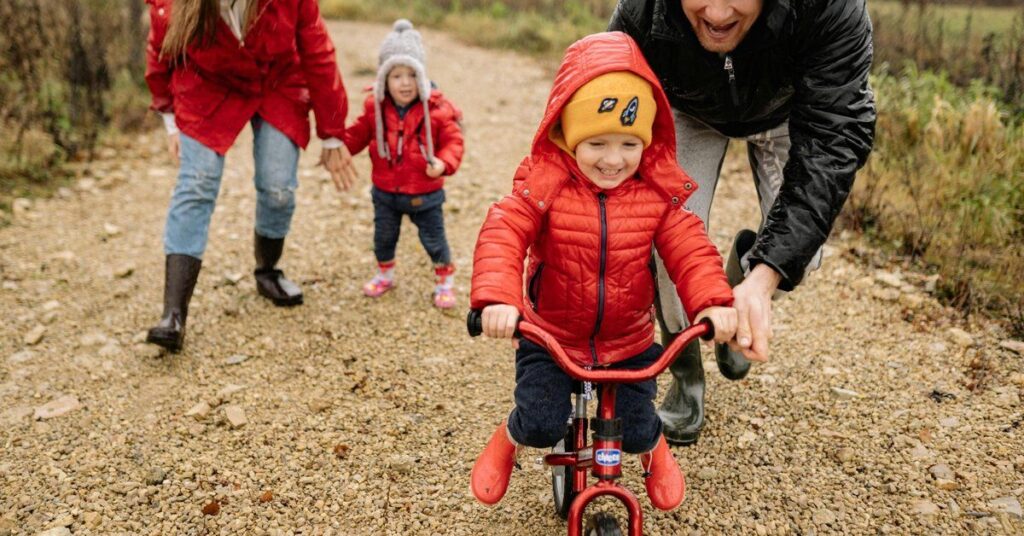Zero-stress, low-mess activities that turn everyday stuff into family fun, learning, and memories—without glue guns, fancy tools, or art degrees.
Why Simple, No‑Skill Projects Are Powerful
You don’t need to be “crafty” to build connection. Kids want time, attention, and a chance to help. When projects are simple, everyone participates. No one gets stuck cutting tiny shapes or cleaning glitter from the rug. That means more laughs, more learning, and less stress.
Quick builds using tape, blankets, boxes, or kitchen odds and ends also support early STEM thinking: planning, testing, comparing sizes, and problem‑solving. The best part? Because nothing is “perfect,” kids feel free to experiment and make it their own.
Below you’ll find eight family‑tested ideas that work across ages, budgets, and busy schedules. Each includes what you need, 3 easy steps, learning boosts, and an image suggestion so you can snap photos for memory books—or for your parenting blog!
Grab‑n‑Go Supply Basket
Keep a clear bin so project time starts fast. Rotate items as you use them.
- Painter’s or masking tape
- Washable markers / crayons
- Old socks / clean mismatched
- Aluminum foil
- Flattened cardboard pieces (cereal boxes!)
- Plastic bottles / yogurt cups (clean & label‑free)
- Child‑safe scissors (adult cuts tougher materials)
- Blankets / pillows / clothespins
- Flashlight or phone light
Family Safety & Low‑Mess Tips
- Work on a wipe‑clean surface or spread newspaper.
- Use painter’s tape; it lifts off floors and walls more gently than standard tape.
- Pre‑cut tricky shapes (cardboard slots, bottle tops) out of kid view.
- Keep small bits (caps, foil balls) away from children who still mouth objects.
- Snap a “before” photo—kids love comparing start vs. finish!
1. Tape‑Town Floor Roads
Create a city grid on the floor using painter’s tape. Add toy cars, blocks, and even stuffed‑animal bus stops.
- Lay long tape lines for main roads.
- Add cross streets, parking spots, or roundabouts.
- Place blocks for buildings; label with sticky notes.
Spatial awareness, early mapping, turn‑taking (“My car waits at the stop!”).
2. Sock‑Puppet Story Studio (No‑Sew)
Use clean socks plus markers, tape, and paper eyes to create improv characters. Put on a mini show from behind the couch.
- Roll sock onto hand; pinch to show mouth.
- Draw eyes / glue paper circles with tape loops.
- Name the puppet & act a 3‑scene story: start, problem, silly fix.
Language skills, confidence speaking, emotion labeling.
3. Foil Sculpt & Guess Game
Crumple, bend, and shape aluminum foil into animals, tools, or mystery shapes. Others guess before you reveal.
- Tear a sheet; scrunch main body.
- Twist legs / wings / handles.
- Hold up—“What do you think it is?”
Fine motor control, visualizing 3D shapes, vocabulary building through guessing clues.
4. Cardboard Slot‑Together Builds
Cut simple slots in flat cardboard pieces so kids can slide them together like giant building blocks—towers, rockets, creatures!
- Draw basic shapes (rectangles, circles, stars) on cardboard and cut out.
- Adult slices centered slots wide enough for another piece.
- Kids connect pieces upright; decorate with markers or tape flags.
Engineering thinking, balance, trial‑and‑error problem solving.
5. 5‑Minute Blanket Fort Lab
Classic living‑room fort—upgrade it! Test which chairs, books, or clothespins hold blankets best. Add a flashlight reading nook.
- Drape blanket over two chairs.
- Anchor edges with books / tape / pillows; test which holds longest.
- Climb in with books, snacks, or puppets from Project 2.
Cause‑and‑effect, basic physics (weight & tension), cozy reading motivation.
6. Recycled Bottle Mini‑Garden
Turn clear plastic bottles into tiny greenhouses for herb seeds or kitchen scraps (green onion ends, lettuce bases).
- Adult cuts bottle in half; poke drainage holes.
- Fill with soil; plant seeds or veggie scraps.
- Mist daily; mark heights on bottle with marker dates.
Life cycles, patience, basic data tracking (measure, record, compare).
7. Family Photo Treasure Hunt
Use a phone or old digital camera. Make a list: something red, three circles, dad’s shoes, letter M in the house. Kids snap the finds.
- Create 5–10 photo clues (use drawings for pre‑readers).
- Kids photograph each item or pattern.
- Review photos; vote funniest shot; print favorites.
Observation, color recognition, early literacy when using letter hunts.
8. Shadow Theater Wall Show
Darken a room, shine a flashlight at a wall, and use hands, paper cutouts, or toys to cast moving shadows. Add sound effects!
- Point light at blank wall.
- Hold hands or shapes in beam to create characters.
- Act a short scene: dragon vs. brave bunny!
Imagination, storytelling, understanding light and shadow.
Wrap‑Up & Next Steps
Simple wins. When projects stay quick and flexible, kids join in, parents relax, and learning sneaks into play. Try setting a weekly Family Build Hour. Let kids choose from the list, or mix projects—put puppets in the blanket fort city you mapped with tape roads!
Snap photos, jot what worked, and repeat favorites. Over time you’ll build a family tradition and a library of easy activities you can pull out anytime school is closed, it’s raining, or screens need a break.
If you publish parenting content, include step photos, short how‑to clips, and a quick safety note for younger ages. These help readers trust you and meet Google quality guidelines.

